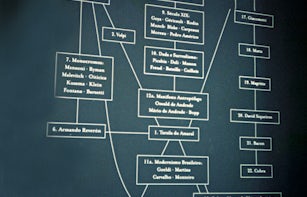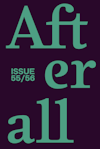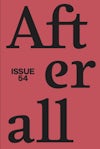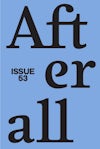
Issue 22
Autumn/Winter 2009
Issue 22 features Sheela Gowda, Jos de Gruyter & Harald Thys and Art Club 2000. Accompanying essays look at the New Orleans biennial and Transforma Projects, the 1970s São Paulo biennials, and imageless film.
Editors: Pablo Lafuente, Nuria Enguita Mayo, Dieter Roelstraete, Melissa Gronlund.
Founding editors: Charles Esche, Mark Lewis.
Table of contents
Foreword
Contextual Essays
- Beyond the Appearance of Imagelessness: Preliminary Notes on Zen for Film’s Enchanted Materialism – Herman Asselberghs
- Art and Its Cultural Contradictions – Joshua Decter
Artists
Sheela Gowda
- The Specific Labour of Sheela Gowda – Trevor Smith
- Sheela Gowda and Christoph Storz in conversation with Suman Gopinath – Suman Gopinath
De Gruyter & Thys
- Systems Failure: The Embarrassing Antics of de Gruyter & Thys – Judith Wilkinson
- The Silence of the Lamps — The Autism of the Recent Works of Jos de Gruyter and Harald Thys – Joshua Simon
Art Club 2000
- AC2K, A.F.A., Co. & C. de L. – Jackie McAllister
- Do you, promise not to transform? – Gareth James
Events, Works, Exhibitions
- The Imaginary Martial Theatre of the Emperor Tomato Ketchup – Thomas Dylan Eaton
- Termite Tracks: Routine Pleasures and the Paradoxes of Collectivity – Michael Ned Holte
- The Bienal de São Paulo: Unseen/Undone (1969—1981) – Isobel Whitelegg Afterword
Foreword
Written by Charles Esche & Thomas Lawson
This issue signals a change, and a new beginning for Afterall. After eight years and seventeen issues together, our partnership with Los Angeles comes to an end; we say a very amicable goodbye and good luck to our collaborators at the California Institute for the Arts and a welcoming hello to our new partners at UNIA in Seville.
This issue signals a change, and a new beginning for Afterall. After eight years and seventeen issues together, our partnership with Los Angeles comes to an end; we say a very amicable goodbye and good luck to our collaborators at the California Institute for the Arts and a welcoming hello to our new partners at UNIA arteypensamiento in Seville.
Back in 2001 a trans-Atlantic partnership was a compelling idea for Afterall, a way to explore the important cultural ties between Europe and the United States, particularly at a time when the Bush Administration seemed intent on aggressively pursuing policies that would isolate the US from much of Europe. Given such a context, our conviction was that, while the challenge of producing an art journal across two continents was ambitious, it was necessary. By being based in both continents, we sought to respond equally to the ideas and desires of our local art communities, while serving as a medium for communication and exchange between them. What made this possible was a shared interest in the role that writing about art could play, not only as a means to illuminate artworks but as also an extension of artistic practice. Going into this partnership we might have assumed that the logistical issues of time and space, the eight hours and 5,000 miles that separated us, would be something of a struggle. But our experience was otherwise, and indeed the productive editorial differences in our views of art have rarely corresponded to our geographic locations. These differences came out of discussion and debate, and most of all through our collective passion for art.
Since the journal’s beginnings in 1999, there was always a healthy tension between a focus on the pictorial possibility of art and its contextual unfolding in different social and political circumstances. This bipolar attraction was in part embodied in the difference between an artist and a curator as the two founding editors – Mark Lewis and Charles Esche – and served always as a provocative and effective check on one or the other view holding too much sway. Thomas Lawson, with his background as artist and educator, added to the mix in complex ways, representing a more interdisciplinary approach alongside an attention to a dynamic Californian and Pacific-rim scene. Embracing these divergent interests within a coherent whole has been one of the enjoyable challenges of Afterall as it has developed, and with the merger with AS journal through the association with MuKHA in Antwerp in 2006, the recipe and the inheritance of the publication became even richer. Throughout the US-European collaboration there have also been important staff changes in the editorial team that have had great influence over its direction. We are proud of the way the journal has developed and we would like to thank all the people who have been involved at different stages in its production in all our locations. In recent years Afterall has grown as an organisation in London with the addition of new titles and projects such as the One Work series, the Afterall readers and the forthcoming Exhibition Histories. Meanwhile, in Los Angeles, a recognition that existing publishing models are under huge pressure from the networked space of the ‘blogosphere’ ignited a prolonged consideration of alternatives that would allow for more attention to the local without sacrificing the broader scope of an international view. In time it became clear the two directions of London and Los Angeles were incompatible, and we agreed to part ways. Moving forward, Afterall has set up a new editorial collaboration with UNIA in Seville, from whence a new editor, Nuria Enguita Mayo, has been appointed. The journal will continue, as always, to be committed to the idea of broadening its scope by working with different institutions and across a diversity of geographic locales. It will be its challenge to experiment with ways of representing the complexity of artistic discourse today while maintaining a focus on artistic processes and their relation to the public sphere. At the same time a new publishing venture in Los Angeles, East of Borneo, will consist of an imprint of books and, most importantly, an extensive and dynamic website – part contemporary art magazine, part multi-media archive – that will reflect the sprawling, rhizomatic nature of Los Angeles and the international art world. East of Borneo, with generous support from both the Getty Foundation and the Andy Warhol Foundation, will launch in early 2010.
Purchase
The publication is available for purchase. If you would like specific articles only, it is also available individually and to be downloaded as PDFs.
Purchase full publication
Buy via University of Chicago Press
Buy via Central Books
Purchase individual articles
Buy via University of Chicago Press





